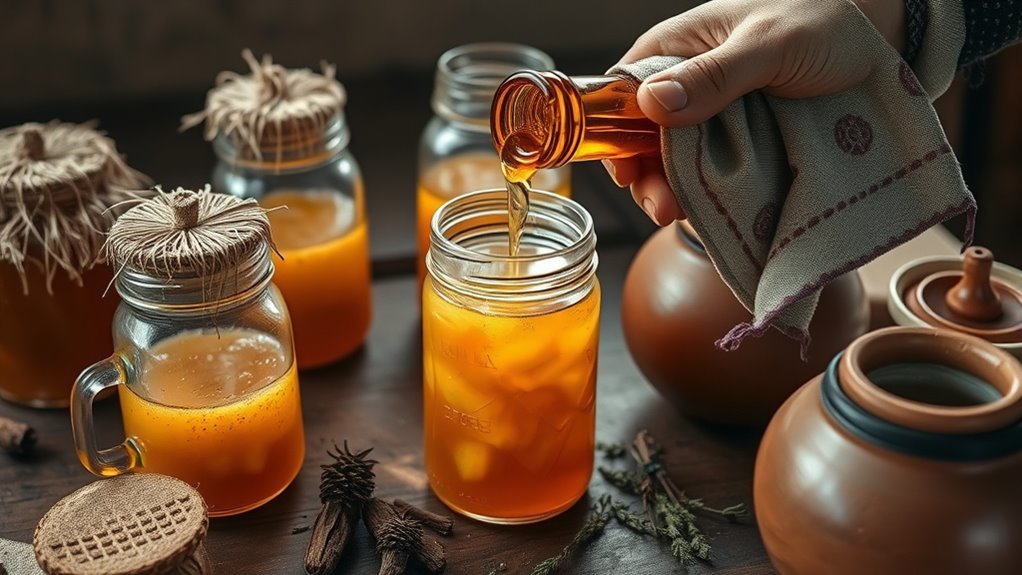To brew Ethiopian Tej honey wine at home, start with high-quality, raw honey that suits your flavor preference. Use sanitized equipment and maintain a steady temperature of around 75-80°F during fermentation. Allow the natural yeasts to work for at least a week or more, monitoring bubbles and froth. Patience and attention to environmental details help develop a vibrant, authentic flavor. Keep exploring to discover more tips for crafting your perfect Tej.
Key Takeaways
- Use high-quality, raw honey with distinctive floral notes and ensure proper sanitation of all brewing equipment.
- Maintain a steady fermentation temperature of 75-80°F (24-27°C) with airlocks to prevent contamination.
- Allow fermentation to proceed for several weeks, monitoring activity, before bottling to develop flavor and potency.
- Choose honey varieties (light or dark) based on desired flavor profile and consider blending for unique tastes.
- Practice patience and environmental control throughout fermentation for a balanced, authentic Ethiopian Tej honey wine.

Have you ever wondered how traditional Ethiopian Tej honey wine is made? If you’re interested in brewing your own, understanding the fermentation techniques and honey selection is vital. These steps determine the flavor, potency, and authenticity of your Tej. Starting from scratch means paying close attention to each detail, especially since Tej’s unique taste hinges on careful craftsmanship.
First, let’s talk about fermentation techniques. Tej relies on natural fermentation, where wild yeasts convert sugars into alcohol over time. To replicate this, you’ll need to create a controlled environment that encourages healthy fermentation. Begin by sanitizing all your brewing equipment thoroughly—this prevents unwanted bacteria from spoiling your batch. When you mix your honey with water, keep the temperature steady around 75-80°F (24-27°C). Using a fermentation vessel with an airlock allows gases to escape while keeping contaminants out, ensuring a clean fermentation process. It’s important to monitor the fermentation closely, checking for activity—bubbles and froth are signs that your yeast is working. Depending on your preference, fermentation can last from a week to several weeks, during which the yeast transforms the sweet honey mixture into rich, honey-infused alcohol. Patience is key here; rushing the process can result in an underdeveloped flavor. Once fermentation slows down, you can proceed to the next step, but don’t rush to bottle until you’re confident that fermentation has fully completed. This careful approach guarantees that your Tej will have the right balance of sweetness and alcohol. Additionally, controlling environmental factors such as temperature and hygiene is crucial for consistent results and optimal fermentation. Proper monitoring ensures the yeast activity remains steady and healthy throughout the process.
Understanding the honey selection process can help you craft a more authentic and flavorful Tej. Honey’s floral and aromatic qualities vary widely depending on its source, so choosing the right type is essential for achieving your desired taste profile. Traditional Ethiopian honey, often sourced locally, is usually unfiltered and contains unique floral notes that influence the final product. For best results, it’s also helpful to be aware of the raw honey category, as raw honey retains more of its natural enzymes and aromatic compounds, enhancing fermentation and flavor. Honey’s characteristics, such as floral notes and texture, directly impact the complexity and richness of your honey wine. Honey’s floral and aromatic qualities vary widely depending on its source, so choosing the right type is essential for achieving your desired taste profile. For your homemade batch, opt for high-quality, raw honey—preferably organic—to maximize flavor complexity. The type of honey you choose will impact the aroma, sweetness, and overall character of your honey wine. Light honey varieties, like acacia, produce a delicate, subtle flavor, while darker, more robust honeys like buckwheat give a richer, more intense profile. It’s also worth experimenting with blends to create a customized flavor profile. Remember, the honey you select should be fresh; older honey may have lost some of its aromatic qualities. As you prepare to mix your honey with water, keep in mind that the honey’s natural sugars are what fuel fermentation, so quality and purity are paramount. By paying attention to honey selection and applying proper fermentation techniques, you set a solid foundation for brewing a vibrant, authentic Ethiopian Tej at home.
Frequently Asked Questions
How Long Does Tej Honey Wine Typically Ferment?
The fermentation timeline for tej honey wine usually lasts about one to three weeks, depending on your desired flavor. During this period, yeast activity is at its peak, transforming honey into alcohol and carbon dioxide. You should monitor the fermentation process closely, tasting periodically, to guarantee it reaches your preferred dryness or sweetness. Once the yeast activity slows down and bubbles diminish, it’s time to bottle your homemade tej honey wine.
Can I Use Alternative Sweeteners Instead of Honey?
Thinking about sweetener substitutions is like exploring a new flavor adventure. You can use alternatives like maple syrup, agave, or fruit juices, but keep in mind they may affect fermentation speed and taste. Different sweeteners contain varying sugars, so fermentation might be faster or slower. Experiment carefully, and remember that honey’s unique properties give tej its distinctive character, so substitutions may alter the final product’s flavor and fermentation process.
What Equipment Is Essential for Brewing Tej at Home?
To brew tej at home, you need essential equipment like a fermentation vessel, such as a glass or food-grade plastic container, and a stirring utensil. You must also sterilize all equipment to prevent contamination during traditional fermentation. A fine cloth or airlock helps control airflow. These tools guarantee a clean environment, allowing the honey wine to ferment properly and develop its authentic flavor.
How Do I Prevent Contamination During Fermentation?
Did you know proper sanitation practices can reduce contamination risks by up to 90%? To prevent contamination during fermentation, you need to carefully control your environment. Always sterilize your equipment thoroughly, and keep the fermentation environment clean and free from dust or pests. Cover your fermenter with a breathable cloth to allow airflow while preventing airborne contaminants. Regularly check for mold or odd odors, and maintain consistent temperature to ensure a healthy fermentation.
Is Tej Suitable for All Dietary Restrictions?
Tej is generally suitable for many dietary restrictions because it’s made mainly from honey, water, and gesho leaves. It’s naturally gluten-free and vegan-friendly, making it a good option for those avoiding gluten or animal products. However, always check for added ingredients or impurities that might affect your dietary needs. If you’re unsure, ask the brewer or check labels to verify it meets your specific restrictions.
Conclusion
Now that you’ve brewed your own Ethiopian Tej honey wine, you’re officially a liquid legend. This isn’t just a drink; it’s a golden potion that can turn any gathering into a legendary feast. With every sip, you’re wielding the ancient magic of Ethiopian tradition, creating a masterpiece that rivals the gods themselves. So, go ahead—raise your glass high and toast to your epic brewing skills. You’ve just discovered the secret to divine, honeyed perfection!









